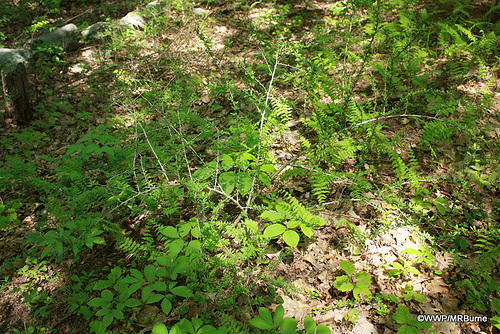Japanese Barberry
(Berberis thunbergii)
Family: Barberry family (Berberidaceae)
Native Range: Japan

Overview: Deciduous, thorny shrub. Dense in full sun but sparse in shade.
Size: Typically 2 to 8 ft tall
Leaves: Small (½ to 1 ½ inches long), oval to spatula-shaped, green, bluish-green, or dark reddish purple.
Stem/Bark: Brown, deeply grooved, somewhat zigzag in form and bear a single very sharp spine at each node
Flowers: Mid-April to May. Pale yellow flowers about ¼ in across hang in umbrella-shaped clusters of 2-4 flowers each along the length of the stem
Seed/Fruit: Bright red berries about 1/3 in long on narrow stalks. They mature during late summer and fall and may persist through the winter. Seed have a high germination rate, estimated as high as 90%.
Roots: Yellow, shallow, fibrous with rhizomes.
Reproduction: Spreads by seed, primarily via wildlife eating the fruit, and by vegetative expansion through branches touching the ground that can root to form new plants and displaced root fragments.
Ecological Threat
- Forms dense stands in natural habitats which displaces native plants and reduces wildlife habitat and forage
- White-tailed deer avoid browsing Japanese barberry, preferring to feed on native plants, giving the plant a competitive advantage
- Alters soil pH, nitrogen levels, and biological activity in the soil
Human Impacts
The shrub creates a humidity chamber ideal for tick reproduction. Small critters will use this thorny plant as a refuge from predators. While under the shrub the ticks on the animal will fall off/new ticks will attach. Researchers have found higher tick populations and Lyme disease abundance in areas with more barberry than those with native plants.
Distribution and Background

Japanese barberry was introduced to the U.S. and New England as an ornamental plant in 1875 in the form of seeds sent from Russia to the Arnold Arboretum in Boston, Massachusetts. In 1896, barberry shrubs grown from these seeds were planted at the New York Botanic Garden. Japanese barberry was later promoted as a substitute for common barberry (Berberis vulgaris) which was planted by settlers for hedgerows, dye and jam, and later found to be a host for the black stem grain rust.
Due to its ornamental characteristics, Japanese barberry is still widely propagated and sold by nurseries for landscaping purposes in many parts of the U.S. It is regularly found in landscaped areas throughout the state.
Habitat Type
Japanese barberry is shade tolerant, drought resistant, and adaptable to a variety of open and wooded habitats, wetlands and disturbed areas. It prefers to grow in full sun to partial shade but will flower and fruit even in heavy shade.
Management Options
Manual control works well but may need to be combined with chemical in large or persistent infestations. Remove as much root as possible. If not feasible, prevent seed production.
Biological
No biological control is available.
Manual
Begin removal efforts in early spring. Pull small plants by hand when the soil is damp and loose, using thick gloves to avoid injury from the spines. Remove the entire root system. Dig up young plants with a hoe or shovel.
Mechanical
Use of a hoe or Weed Wrench ® to add leverage to remove more established roots. Shrubs can be repeatedly mowed or cut. Mow and cut the plant in late summer to reduce seed production.
Chemical
Treatments using the systemic herbicides glyphosate (such as Roundup®) and triclopyr (such as Garlon) have been effective in managing Japanese barberry infestations that are too large for hand pulling.
For foliar treatments, apply a 2% solution of glyphosate mixed with water and a surfactant. Use this non-selective herbicide with care to avoid impacting non-target native plants. Apply early in the season before native vegetation has matured to minimize non-target impacts.
Application in late summer during the fruiting period may be most effective. Use triclopyr or glyphosphate on cut stumps, with a 25-30% concentration of the active ingredient. Make sure to apply the herbicide immediately after the stem is cut.
Notice: Mention Of Pesticide Products On This Web Site Does Not Constitute Endorsement Of Any Material. See Control and Disposal Methods for descriptions of application types and warnings.
Disposal
Compost on site in a discrete pile.
Look-alikes
- American barberry (Berberis canadensis), the only native species of barberry in North America. American barberry is native to the southeastern United States, only occurring in the northeast as a rare introduction. Though with climate change it may become more abundant.
- Common barberry (Berberis vulgaris) which is also classified as invasive.
- In contrast to Japanese barberry, which has smooth-edged (entire) leaves, the leaves of both American and common barberry have fringed edges. These two species also typically have two or three spines at each node in contrast to the single spine in Japanese barberry.
Alternative Plants (Alternative native Species)
Many attractive native shrubs are available that make excellent substitutes for Japanese barberry and are readily available. Some examples for the eastern United States include:
- Ink-berry (Ilex glabra)
- Winterberry (Ilex verticillata)
- Mountain laurel (Kalmia latifolia)
- Bayberry (Myrica pensylvanica)
- Arrowwood viburnum (Viburnum dentatum)
More Information
For more information on invasive species in Massachusetts, refer to the Massachusetts Prohibited Plant List at https://www.mass.gov/massachusetts-prohibited-plant-list.